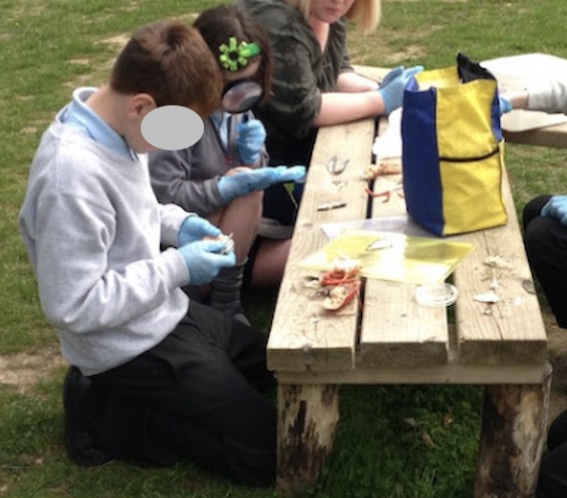Many years ago I had a wonderful few days holiday over on the West Coast of Scotland. My family and I stayed at the Pier House Hotel in Port Appin which wins lots of awards for being friendly, welcoming and having an amazing seafood restaurant.
On the last night, to celebrate the ascent of Ben Nevis, my ex-husband and son had a seafood platter with lots of fine local seafood which included: lobster, langoustines, scallops, smoked hot & cold salmon, mussels, oysters and crab claws. It was indeed a feast!
With seafood, there’s a lot leftover in terms of shells, heads and other body parts. With such an unusual array of food, I organised for it to be cleaned and stored in a fridge for immediate home removal! Back home, I gave the leftovers a second thorough clean, removing as much flesh as possible. The only exception to this was the lobster as I wanted the children to be able to examine the roe – the eggs.

Because I was removing the cooked flesh, I felt the children were going to be missing out on a key experience. So I nipped into the supermarket on the way to school and picked up a few crevettes (a type of prawn) and sardines. Sadly these weren’t local. However I wanted the children to be able to examine some fresh meat. These were added to the refrigerated seafood skeletons and shells.

Whilst food hygiene guidelines did not apply as we were not preparing food to eat, I still wanted to ensure that the children understood certain matters. We agreed to wear gloves, not least to avoid our hands becoming really smelly (this was the main reason for working outside – the smell was blown away). Those who were using the tiny sharp pocket knife, pair of tweezers and peeler had to be extra careful, remain in the one place and to share the utensils. We decided we needed to be sensible about our behaviour. We were not to lick, taste or eat any of the material. Handwashing facilities were available in our classroom which was very close by.

Most importantly, no-one had to undertake this activity. At the same time, an alternative gardening activity was offered in a different part of the school grounds. Sometimes the smell can be off-putting. For other children, they may not have been happy to examine seafood for personal, cultural or religious reasons. The choice was entirely the children’s. One child did not like idea because he hated the smell but came for a look and ended up staying for the whole session!

One discovery we quickly made was that the langoustine exoskeletons make fantastic finger puppets! To eat langoustines, you remove the head and eat the body. One the head is cleaned out, it makes a perfect hole for a finger. One child spent a long time with two such puppets creating conversations between them.

Another child really enjoyed looking closely at the sardines with a magnifying glass. I provided lots of lenses of different sorts as its a good opportunity to really look at the beauty of the fish scales, gills, fins and the lobster roe.

Some children were really keen on filleting and pulling apart the exoskeletons. What interested me were the conversations that took place as the children examined and explored the seafood. To being with, one child did not quite understand that the lobster and langoustines and crevettes were already dead. I think the eyes made them seem alive! We discussed how to peel the crevettes and various other culinary matters.

The pincers were a source of fascination as the crab claws could move. One child really liked filleting the sardines and trying to remove the fragile skeletons. We looked for different internal organs too but they were hard to find in such small fish.

The activity kept the children fully engaged for at least 40 minutes. When the class teacher came and saw the photos, he proposed that the children should now get the opportunity to cook at eat some fish on a campfire. So the outdoor explorations of food, where it comes from and what it actually is, continued.
This blog post was originally published in May 2013.






























Haha I would love to have seen the looks on the faces of the restaurant staff when you requested all the left overs!!
What an amazing lesson & again with a real context the children will be able to call on again & again when they are back inside doing more tradtional ‘boook learning’.
I remember loving exploring fish as an 11 year old, especially the eyes in a biology lesson.
Luckily, the staff were a great bunch of people and the cook too! If I hadn’t known the owner, I probably wouldn’t have dared ask.
Sounds like they are beautifully set up for stage two of cooking on a campfire. Plenty to be learnt from the fish examination and yum to your meal! Thanks for sharing.
Yes – I think knowing about your food helps children appreciate what it is and where it comes from. It was a spur of the moment activity.